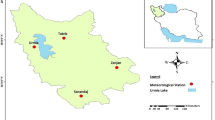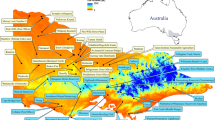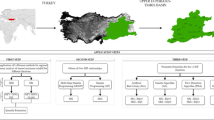Abstract
This article discusses a rescaled range analysis model, titled AGA-R/S, that is based on an accelerated genetic algorithm. The parameter a, Hurst index of rescaled range analysis, and the recurrent time of disaster in the next time-period, were directly computed using an accelerated genetic algorithm developed by the authors. As case studies, using the AGA-R/S model, a forecast was made of the tendency for change in a time series of annual precipitation for the city of Jinhua, China. The model also forecast flooding-disaster in the city of Wuzhou, China. Results indicate that it is a relatively efficient technique to forecast the change-tendency of flood and disaster time series using the AGA-R/S model. When time series is utilized, forecasted error of the AGA-R/S model is less than with a linear least square method. The Hurst indexes of the two cities are from 0.23 to 0.24, which indicates that these time series are fractal and relatively long-term. Their fractional Brownian motion shows anti-persistence. AGA-R/S has application in forecasting the change-tendency of other natural disaster for specific time series.

Similar content being viewed by others
References
Cheung Y, Lai KS (1995) A search for long memory in international stock market returns. J Int Money Finance 14(4):597–615
Damle C, Yalcin Y (2007) Flood prediction using time series data mining. J Hydrol 333:305–316
Deng JL (1989) Introduction to grey system theory. J Grey Syst 1(2):1–24
Edgar EP (1994) Fractal market analysis. New York, John Wiley & Sons, Inc, pp 53–79
Feng LH, Wu ZR (2001) Application of R/S analysis to forecasting the variable trend of precipitation. Theory Method Appl Syst Eng 10(1):79–81 (in Chinese)
Frederick KD, Major DC (1997) Climate change and water resources. Climatic Change 37:7–23
Hall JW, Sayers PB, Dawson JS (2005) National-scale assessment of current and future flood risk in England and Wales. Nat Hazards 36:147–164
Hu XH, Yan JP, Ou WX (1999) The flood and waterlog disaster of GuangXi and its tendency forecasting from 1950. J Catastrophol 14(4):27–31 (in Chinese)
Huang DS, Li HQ (1990) Fractal geometry, R/S analysis and fractional Brownian motion. Chinese J Nat 13(8):477–482 (in Chinese)
Huang SF, Jin JL, Wang Q (1998) Application of Genetic Algorithm to estimating fractal dimension of geology. Sci Technol Inform Geol 17(3):81–84 (in Chinese)
Hurst HE (1951) The Long term storage capacity of reserviors. Trans Am Soc Civil Eng 116:770–808
Imamura F, Vanto D (1997) Flood and typhoon disasters in Viet Nam in the half century since 1950. Nat Hazards 15:71–87
Jin JL, Yang XH, Jin BM, et al (2000) Application of bilinear time series model to drought and flood prediction series in Jianghuai area. Meteorol Monthly 26(9):3–7 (in Chinese)
Jin JL, Yang XH, Ding J (2001) Improved scheme of simple genetic algorithm–accelerating genetic algorithm. Theory Practice Syst Eng 21(4):8–13 (in Chinese)
Jin JL, Ding J (2000) Genetic algorithm and its application to water science. Chengdu, Sichuan University Press, 42–57 (in Chinese)
Mandelbrot BB (1967) How long is the coast of Britain? Statistical self-similarity and fractional dimension. Science 156(3775):636–638
Ologunorisa T, Adeyemo A (2005) Public perception of flood hazard in the Niger Delta, Nigeria. Environmentalist 25:39–45
Plate EJ (2002) Flood risk and flood management. J Hydrol 267:2–11
Shi YF (1996) The development tendency of China nature disaster under the influence of global greenhouse effect. J Nat Disasters 5(2):102–116 (in Chinese)
Teng WH, Hsu MH, Wu CH, Chen A (2006) Impact of flood disasters on Taiwan in the last quarter century. Nat Hazards 37:191–207
Wang JF (1993) The evaluation method research on China nature disaster influence. Beijing, Publishing Company of Science and Technology of China, 1–29 (in Chinese)
Wang LJ, Peng BZ (1998) Application of fractal method to forecasting flood and waterlog disaster. Geogr Sci 18(3):242–247 (in Chinese)
Wei YM, Fan Y, Fu JL, et al (2000) Neural network based predicative method for flood disaster. Chinese J Manage Sci 8(3):57–62 (in Chinese)
Wei YM, Jin JL (1998) The research advances of flood disaster research. Nat Explore 17(2):6–10 (in Chinese)
Wei YM, Jin JL, Zhou CH, et al (1998) The fractal character of flood disaster area time series of China from 1949 to1994. J Nat Disasters 7(1):83–86,93 (in Chinese)
Zhou YK (1996) Preliminary research on the flood and waterlog disaster characteristics of Huaihe drainage area. Geogr Res 15(1):22–29 (in Chinese)
Acknowledgments
The authors gratefully acknowledge the financial support from the National Natural Science Foundation of China (NSFC) under the grants Nos.70425001 and 50579009, the Excellence Youth Teacher Sustentation Fund Program of Ministry of Education of China (Department of Education and Person [2002]350). We also would like to thank Professor T.S. Murty and the anonymous referees for their helpful suggestions and corrections on the earlier draft of our paper according to which we improved the content.
Author information
Authors and Affiliations
Corresponding author
Rights and permissions
About this article
Cite this article
Jin, JL., Cheng, J. & Wei, YM. Forecasting flood disasters using an accelerated genetic algorithm: Examples of two case studies for China. Nat Hazards 44, 85–92 (2008). https://doi.org/10.1007/s11069-007-9143-0
Received:
Accepted:
Published:
Issue Date:
DOI: https://doi.org/10.1007/s11069-007-9143-0




